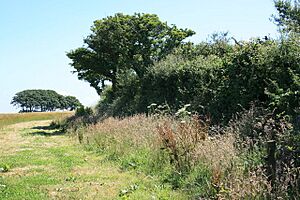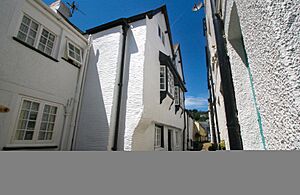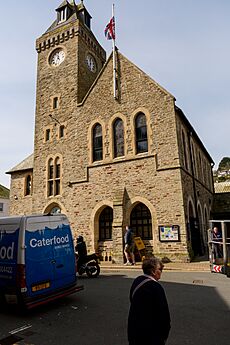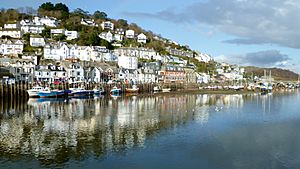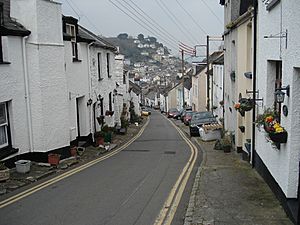Looe facts for kids
Quick facts for kids Looe
|
|
|---|---|
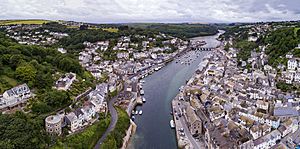 |
|
| Lua error in Module:Location_map at line 530: Unable to find the specified location map definition: "Module:Location map/data/Cornwall (mainland)" does not exist. | |
| Population | 5,112 (United Kingdom Census 2011) |
| OS grid reference | SX254533 |
| Civil parish |
|
| Unitary authority | |
| Ceremonial county | |
| Region | |
| Country | England |
| Sovereign state | United Kingdom |
| Post town | LOOE |
| Postcode district | PL13 |
| Dialling code | 01503 |
| Police | Devon and Cornwall |
| Fire | Cornwall |
| Ambulance | South Western |
| EU Parliament | South West England |
| UK Parliament |
|
Looe (pronounced "loo") is a charming coastal town in south-east Cornwall, England. It's home to about 5,280 people.
The town is split into two parts by the River Looe: East Looe and West Looe. A bridge connects these two sides. Looe is about 20 miles (32 km) west of Plymouth.
Looe is built around a small harbour. The River Looe flows through a steep valley, reaching the sea next to a sandy beach. Just off the coast, to the west, you can see Looe Island.
Discovering Looe's Past
Ancient Times and Early Settlements
People have lived around Looe for a very long time! Archaeologists have found tools from the Neolithic period (the New Stone Age). A stone axe was found in the West Looe River in 1978. Other finds, like flint arrowheads, show that people lived here even before recorded history.
There are also signs of ancient burial mounds, called tumuli, from the Bronze Age. Sadly, many of these have disappeared over time. The area also has many forts from the Iron Age and Roman-British times.
Roman Connections
Some evidence suggests the Romans might have visited or even lived in Looe. In the early 1800s, a Roman urn (a pot for ashes) was found. Roman coins, boat anchors, and pieces of Roman amphorae (large storage jars) have been found near Looe Island. Some historians even think Looe Island might be Ictis, a famous tin trading island mentioned by ancient writers!
The Mysterious Giant's Hedge
One of Looe's biggest mysteries is the "Giant's Hedge." This is an ancient earthwork, like a long wall of earth, that stretches over 9 miles (14 km) between the Looe and Fowey rivers. In some places, it's still 12 feet (3.7 m) high!
Local stories say a giant built it. The rhyme goes: "One day, the Devil having nothing to do, built a great hedge from Lerryn to Looe." Experts believe it was a boundary for an ancient kingdom after the Romans left. Some even think it could be much older, from the Bronze Age. We may never know all its secrets!
How Looe Began
By 1086, the area that became East Looe was owned by William the Conqueror. Land across the river became West Looe.
Looe started to grow in the 12th century. King Henry II gave East Looe a special charter, allowing it to have a Mayor. West Looe also became a free town later. East Looe was designed like a "new town" with streets in a grid pattern.
Because Looe is so close to the sea, it often floods during very high tides. In the past, fishermen built their homes with living areas upstairs and storage downstairs for their boats and tools.
Early Churches and Chapels
Around 1144, monks from the Order of Saint Benedict built a chapel on Looe Island. They also set up a simple lighthouse using beacons.
The main church for East Looe was at St Martin by Looe. But there was also a smaller chapel in town, St Mary's Church, East Looe, dedicated in 1259. West Looe had its own chapel, St Nicholas' Church, West Looe, which was later used as a school but is now a church again.
Medieval and Tudor Times
Looe was an important port in the Middle Ages. In 1347, the town provided about 20 ships for the Siege of Calais in France.
An early wooden bridge over the Looe River burned down. It was replaced by a stone bridge in 1436, which even had a chapel on it! The bridge we see today was opened in 1853.
By the 1400s, Looe was one of Cornwall's biggest ports. It exported local tin, arsenic, and granite. It also had busy fishing and boatbuilding industries. The town was well-connected to the main road from London to Penzance. The textile industry also became important. The Old Guildhall in East Looe dates back to around 1450.
Both East Looe and West Looe had their own Members of Parliament (MPs) until 1832. This meant they had a say in the country's laws.
17th Century Challenges
In June 1625, Looe faced a scary attack from Barbary pirates. These pirates raided the town, but many villagers had been warned and escaped. Still, the pirates captured 80 fishermen and sailors, taking them to North Africa as slaves. The town was also set on fire.
The 1800s: Decline and Revival
By the early 1800s, Looe's luck was changing. The Napoleonic Wars affected the country, and a blockade in 1808 stopped Looe's fishing fleet. The town also suffered from bad storms and flooding.
However, things improved with new transport links. The Liskeard and Looe Union Canal was built in 1828, connecting Looe to Liskeard. This canal helped transport copper and granite from nearby mines. In 1856, a large quay (dock) was built in East Looe to handle more ships.
The canal couldn't keep up with demand, so in 1860, a railway was built along the canal's path. This railway first carried goods, but later, in 1879, it started carrying passengers.
In 1866, a lifeboat station was set up on East Looe Beach to help people in trouble at sea. In 1877, a new town hall, the Looe Guildhall, was built. Eventually, East and West Looe joined under one council in 1898.
20th Century and Beyond: Tourism and Modern Life
With the rise of seaside holidays in the Victorian times, Looe became a popular tourist spot. This continued throughout the 20th century, with more hotels and tourist facilities being built. Fishing and boatbuilding also saw boosts after the World Wars.
Famous New Zealand writer Katherine Mansfield stayed in Looe in 1918 while recovering from an illness.
Today, Looe and its surroundings are used as a filming location for the BBC crime drama Beyond Paradise.
Cornish Wrestling Tradition
Looe has a long history of Cornish wrestling tournaments. These exciting events, where wrestlers compete for prizes, have been held in both East and West Looe for centuries.
Looe Today: A Lively Coastal Town
Looe is still an active fishing town. Its small fishing boats bring in fresh catches daily, giving Looe a great reputation for seafood. It's also a centre for shark fishing, with the Shark Angling Club of Great Britain based here.
However, tourism is Looe's main industry today. The town is full of hotels, guest houses, and holiday homes. You'll find many pubs, restaurants, and shops selling beach gear, ice cream, and Cornish pasties. Inland, there are camping sites and the famous Woolly Monkey Sanctuary.
Visitors enjoy the beaches, sailing, fishing, and diving. The coastal walks are amazing, especially the path to Polperro. Nearby, you can visit stately homes like Antony House and Cotehele, or the famous Eden Project.
Even outside the busy summer months, Looe is a hub for local people to shop and enjoy entertainment. Every September, the town hosts the Looe Music Festival, attracting thousands of music lovers.
A fun tradition in Looe is on New Year's Eve. People dress up in amazing fancy dress costumes, and the streets are packed with party-goers. Looe is known as one of the best places in the UK to celebrate New Year!
Exploring East Looe
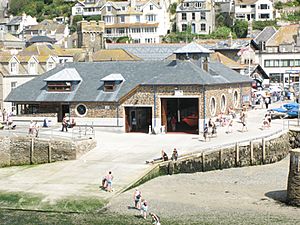
East Looe has a wide sandy beach and the unique Banjo Pier, which is shaped like a banjo. You'll also find the new lifeboat station and St Mary's Church here.
Behind the church, a grid of narrow streets forms the main shopping area. These streets are filled with small shops, restaurants, and pubs. The Old Guildhall is now a museum. Along the river, you'll see the quay where fish merchants work.
Near the bridge is the Victorian Guildhall, and just north of the bridge is the railway station. This is the end of the Looe Valley branch line, which connects to Liskeard. From Liskeard, you can take trains to London Paddington.
On the hill above East Looe are the areas of Shutta and Sunrising, where you'll find Looe Community Academy, a local school. Further along the cliffs to the east are Plaidy Beach and the village of Millendreath.
Exploring West Looe
West Looe stretches west from the bridge along the Polperro Road. Along the waterfront, you'll find hotels, restaurants, and guest houses. Houses climb the steep cliff above, leading to shops and businesses, and the Church of St. Nicholas.
West Looe also has a public recreation area called 'the Downs', popular for dog walking. Further south along the coast is Hannafore Point, which marks the edge of Looe Harbour. To the west is Hannafore Beach, a stony beach facing Looe Island.
The coastal path continues from here towards Portnadler Bay, Talland, and Polperro.
New Year's Eve Celebrations
Looe is famous for its amazing New Year's Eve celebrations! Even though it's a quiet fishing town in winter, thousands of visitors come to join the fun. Everyone, no matter their age, dresses up in fantastic fancy dress costumes. The crowds start in the town and then move towards the seafront for a fireworks display to welcome the New Year. Looe is often listed as one of the top places in the UK to celebrate New Year's Eve!
Twin Town
Looe is twinned with Quiberon in Brittany, France. This means the two towns have a special friendship and often exchange visits.
See also
 In Spanish: Looe para niños
In Spanish: Looe para niños


